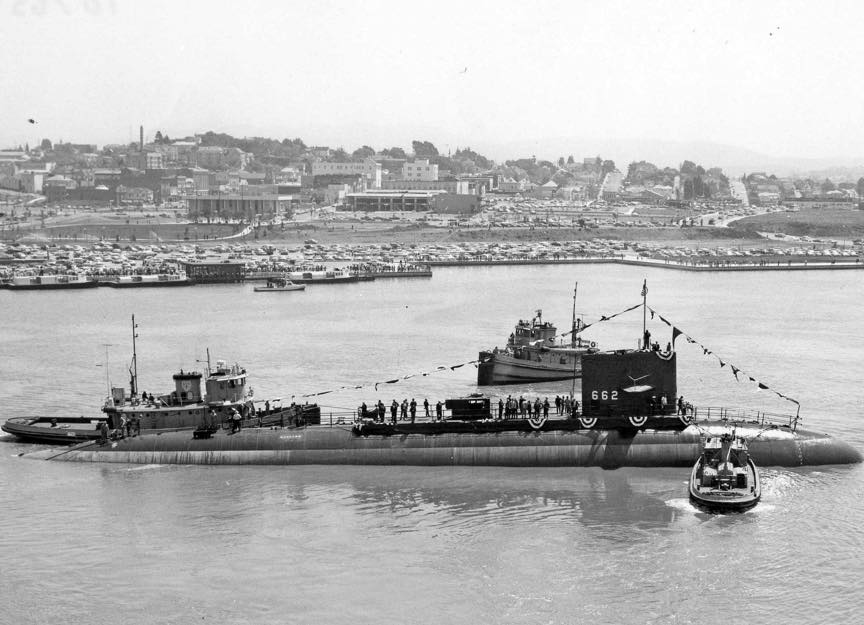
Gurnard
(SS(N)-662: dp. 3,800 (surf.) 4,600 (subm.); 1. 292'3";
b. 31'8"; cpl. 107; a. 421" tt.; cl. Sturgeon)
The second Gurnard (SS(N) 662), a Sturgeon-Class nuclear submarine, was laid down 22 December 1964 by the San Francisco Bay Naval Shipyard, Vallejo. Calif.; launched 20 May 1967; sponsored by Mrs. George P. Miller, and completed in the fall of 1968. Once commissioned, she will become a key element in the underwater deterrent force of the Navy and will contribute vitally to the continuing task of "keeping the peace" over the vast reaches of global waters. Designed to attack and destroy all types of enemy ships, her ability to operator long periods at great depths and at high submerged speed will make her a potent and effective challenge to enemy submarines. Operating under nuclear power, she will be able to conduct long-range reconnaissance patrols and surveillance missions without risking detection by surface ships. Moreover, she will be able to carry out extensive ASW operations, either alone or with other fleet submarines or with destroyer-type surface ships.
On 8 July 1972, USS Barb (SSN-596) lay in Apra Harbor completing repairs prior to a patrol in the Mariana Islands. Typhoon Rita was approaching Guam, and Barb intended to be at sea and submerged before the storm arrived. Shortly after 04:00 hours, "Cobalt 2", a B-52 Stratofortress of the Strategic Air Command commanded by United States Air Force Captain Leroy Johnson, took off from Andersen Air Force Base, intending to fly over the storm. Soon after takeoff, however, the aircraft became uncontrollable, and the crew bailed out. By 05:25, the six-man crew were in the ocean. A C-97 Stratofreighter spotted the survivo' were ordered to proceed at best speed and effect rescue. At about 23:00, Barb surfaced about 12 miles (19 km) from the reported location. The heavy weather had already forced surface ships to turn back, and caused the round-hulled submarine to roll and corkscrew violently. It was 01:15 hours the next morning before the boat's crew spotted the survivors' lights. They made numerous attempts to rescue the airmen through the night, but did not succeed.
By 07:40 hours, visibility had improved and the typhoon had moved from the immediate area, and the boat approached a group of three rafts. Several attempts to shoot a line to the survivors failed, so Chief Torpedoman Jon Hentz volunteered to swim to them, towing a line. At about 08:15, the rafts holding Major Ronald Dvorak, the Electronic Warfare Officer, Lieutenant William Neely III, the copilot, and Lieutenant Kent Dodson, the navigator, were secured to the submarine. Over the next hour, they were brought aboard, a task made more challenging by the 40-foot (12 m) waves that often exposed the submarine's screw and the ballast tank flood grates at the bottom of the boat. At about 10:00 hours, orbiting aircraft vectored Barb to the next survivor, Airman Daniel Johansen, the aircraft's gunner, who caught a line shot to him and was pulled aboard in less than a quarter-hour.
Meanwhile, Gurnard arrived on the scene, found Captain Leroy Johnson, the aircraft commander, and brought him aboard. Lieutenant Colonel J.L. Vaughn, the radar navigator, had not survived the night. Aircraft sighted his body floating face down, still tied to his raft.
The survivors were carried back to Guam, where each boat was presented the Meritorious Unit Commendation, and ten submariners who played perilous topside roles received individual commendations. Torpedoman Hentz received the Navy and Marine Corps Medal.
Gurnard operated in the Arctic Ocean under the polar ice cap from September to November 1984 in company with one of her sister ships, the attack submarine USS Pintado (SSN-672). On 12 November 1984 Gurnard and Pintado became the third pair of submarines to surface together at the North Pole. In March 1990, Gurnard deployed to the Arctic region during exercise Ice Ex '90 and completed only the fourth winter submerged transit of the Bering and Seas. Gurnard surfaced at the North Pole on April 18, in the company of the USS Seahorse (SSN-669).
Decommissioning and disposal[edit]
Gurnard was decommissioned on 28 April 1995 and stricken from the Naval Vessel Register the same day. Her scrapping via the Nuclear-Powered Ship and Submarine Recycling Program at Puget Sound Naval Shipyard in Bremerton, Washington, was completed on 15 October 1997.
